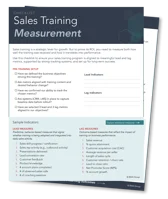Make Training Metrics Work for You
Why Measuring Sales Training Effectiveness Matters
Sales training is a strategic lever for growth. But to prove its ROI, you need to measure both how well the training was received and how it translates into performance. Without meaningful metrics, organizations risk:
- Wasting time and budget on training that doesn’t stick
- Missing opportunities to reinforce behavior change
- Struggling to secure executive buy-in for future initiatives
To measure effectively, organizations need both short- and long-term indicators that capture the full arc of impact. A strong measurement framework includes:
- Lead indicators: Predictive, behavior-based measures that signal whether training is being adopted and integrated into daily sales activity.
- Lag indicators: Outcome-based measures that reflect the impact of training on business performance.
Together, these provide a complete picture of training effectiveness.
[Checklist] Measure Your Sales Training Programs with Confidence
Prove ROI and performance improvement with this checklist designed to help you align your training programs to significant lead and lag metrics.
Key Sales Metrics to Measure Training Effectiveness
Lead Indicators: Measuring Immediate Training Impact
Lead metrics are predictive indicators tied to post-training behavior change. They reflect whether the training is being applied in practice and whether it's likely to drive results. Examples include:
Training Completion & Engagement
Who completed the program? How engaged were they? At RAIN Group, LMS engagement is a core indicator. Facilitators also provide qualitative feedback on participation, energy, and interactivity during live sessions.
Knowledge Retention
Post-training quizzes, assessments, and certifications help ensure key concepts are sticking.
Behavioral Adoption
Are sellers consistently applying what they learned? This can be one of the most difficult metrics to quantify, yet it’s essential for assessing whether training is translating into on-the-job behavior change. Look at:
- Role-play evaluations and ride-alongs
- AI-driven conversation intelligence tools
- Scoring rubrics tracking specific behaviors across calls and emails
Tip: Don’t just search for one perfect call. Track a volume of changed behaviors to reveal true adoption.
Manager Feedback & Coaching Data
Are frontline managers observing and coaching to specific behavioral changes? Incorporate direct observational feedback into coaching plans to strengthen the connection between training and field performance.
CRM Activity Metrics
Track measurable increases in seller activity, such as prospecting calls, meetings booked, and proposals submitted, to assess early signs of applied learning.
Pipeline Growth & Acceleration
While sometimes viewed as a business result, pipeline growth is better classified as a leading indicator. It reflects increased opportunity creation and sales activity—clear signals that sellers are applying what they learned.
Seller Confidence Surveys
Confidence drives behavior. Conduct pre- and post-training surveys to assess reps’ perceived skills in key areas.
Example: “On a scale of 1–5, how confident are you in leading discovery conversations?”
Lag Indicators: Measuring Business Impact Over Time
Lagging indicators measure the long-term business outcomes that result from consistent behavior change. They help assess whether training has contributed to achieving strategic goals. Common lag measures include:
- Win rate (lead-to-close ratio)
- New customer acquisition
- Average deal size or revenue per customer
- Upsell and cross-sell success
- Overall revenue growth
- Profit margin improvement
Overcoming Common KPI Tracking Challenges
Even after defining KPIs, many organizations get stuck when it comes to consistent tracking and behavior change. Based on our work with clients and research from the RAIN Group Center for Sales Research, here are the most common challenges and how to solve them.
Challenge: No Tracking Systems in Place
Solution: Start by leveraging your existing CRM and LMS platforms for initial data collection. These systems often contain the engagement, activity, and performance data you need to begin.
Tip: Partner early with operations or IT to define data fields, build custom reports, and automate workflows.
Challenge: Lack of Leadership Buy-In
Solution: Pilot programs can demonstrate business value in a controlled way. Just keep timing in mind; sales training impact can take time to show. Set clear expectations with leadership about what changes are realistic at each milestone (30-60-90 days), especially during pilots. Align on whether you're targeting minimum baseline change or stretch goals, and clarify what progress will be reported, and when. Ensure alignment across sales leadership, enablement, and operations so that reporting milestones are meaningful and attainable.
Challenge: Sales Managers Not Reinforcing Training
Solution: Integrate coaching expectations into manager scorecards and hold them accountable. Provide coaching guides aligned to training content so managers can reinforce what reps are learning.
Challenge: Inconsistent Data Collection
Solution: Clearly define KPIs, standardize what counts as a key behavior (e.g., discovery call, opportunity creation), and train sellers on proper CRM hygiene.
Task Clarity: The Missing Link Between Training and Performance
Even with tracking systems and coaching programs in place, many organizations still struggle to connect training to actual behavior change. One often overlooked reason: sellers lack clarity on what they’re expected to do differently.
To bridge this gap, define, communicate, and reinforce specific post-training expectations, including:
- What specific behaviors, tools, and messaging sellers should adopt
- When and where they should apply new skills
- How their activity will be reviewed, measured, or coached
RAIN Group’s research shows that task clarity is foundational to top sales performance. Top-Performing Sales Managers are:
- 51% more likely to engage in regular coaching sessions that provide consistent direction and expectations
- 40% more likely to lead high-value coaching conversations that reinforce role clarity and drive adoption
Top sellers thrive in environments with structured coaching, defined processes, and clear, role-specific expectations. Organizations that embed this clarity see higher win rates and stronger revenue performance.
This means mapping KPIs not only to sales stages, but also to engagement criteria and expected behaviors.
Bottom line: If sellers don’t know what success looks like, how can they consistently deliver? And how can you reliably track their progress?
When enablement teams provide role-specific behavior maps, embed expectations into ongoing coaching, and reinforce clarity through dashboards and tools, KPI tracking becomes more actionable, meaningful, and aligned with real business outcomes.
Best Practices for Measuring Sales Training ROI
To maximize ROI measurement, follow these proven practices:
- Align training KPIs with business objectives: Every training outcome should tie to a revenue or performance goal.
- Create a sales training dashboard: Give stakeholders real-time visibility. Compare pre- and post-training performance side by side.
- Leverage sales enablement & AI tools: Automate data collection, analyze call transcripts, and use confidence surveys to assess early impact.
- Run pilot groups: Compare trained vs. untrained cohorts to isolate training effect.
- Regularly review & adjust metrics: As your sales strategy evolves, so should your measurement framework.
- Report to leadership: Translate metrics into a compelling business narrative—“Here’s how training influenced win rates, deal size, and revenue”—to drive executive understanding and support.
These best practices are how leading sales organizations turn training into performance.
Measurement Guides Success
Sales training is only truly effective when it produces measurable outcomes. When measurement is embedded in your culture and tied to strategic goals, training becomes a performance driver, not just a learning initiative. Training impact is cumulative, and meaningful change unfolds over time.








